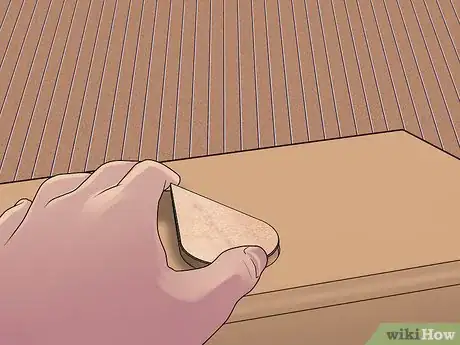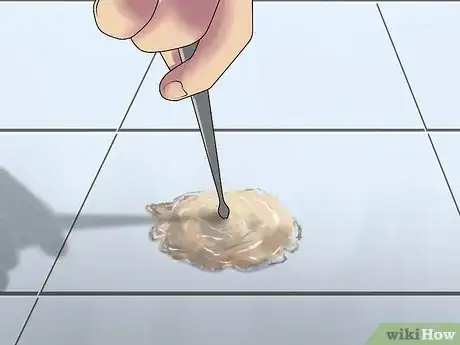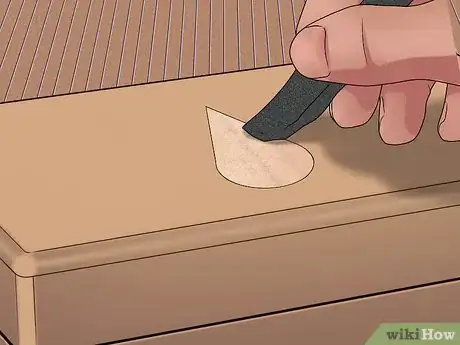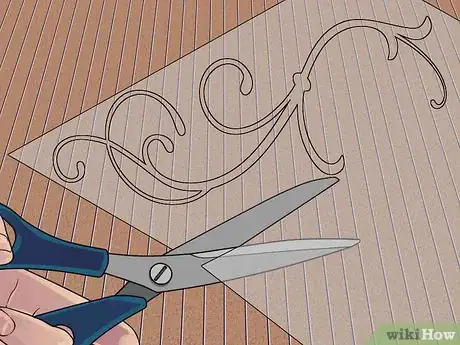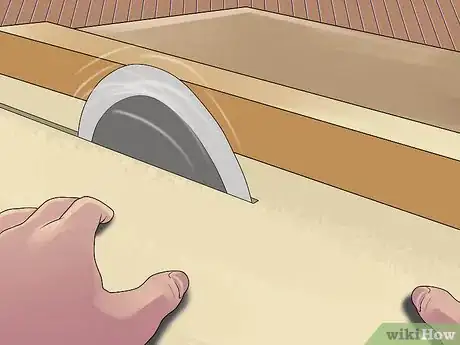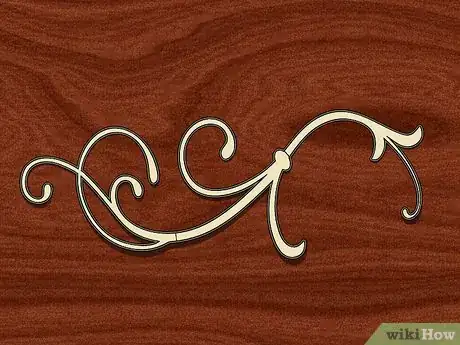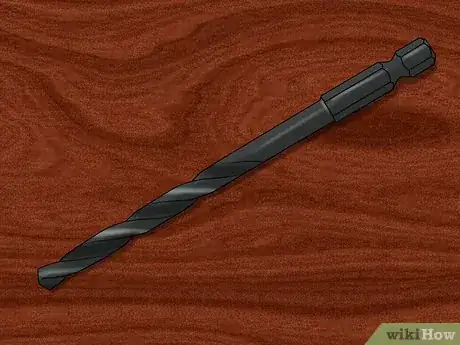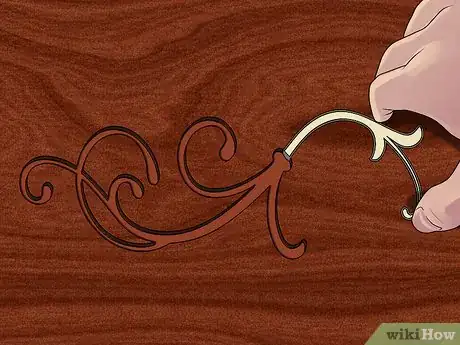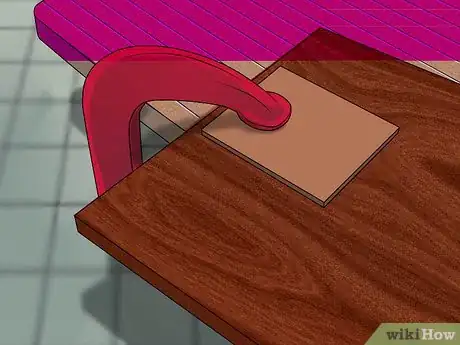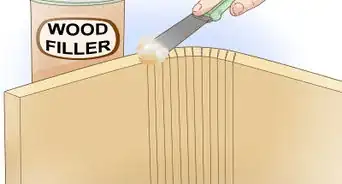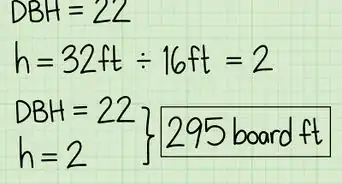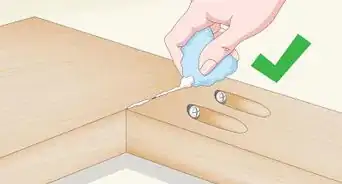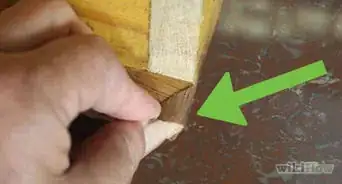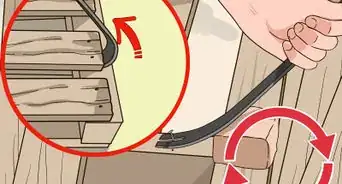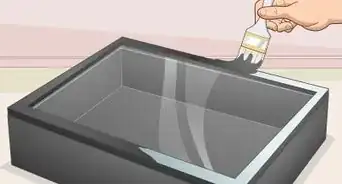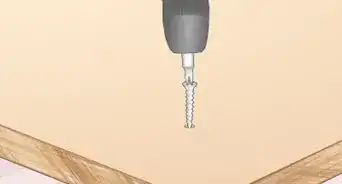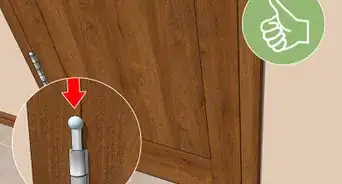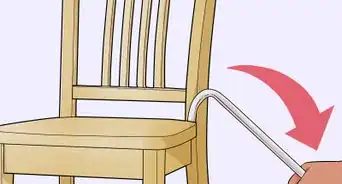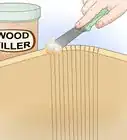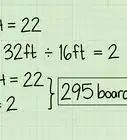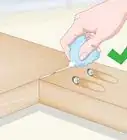wikiHow is a “wiki,” similar to Wikipedia, which means that many of our articles are co-written by multiple authors. To create this article, 15 people, some anonymous, worked to edit and improve it over time.
wikiHow marks an article as reader-approved once it receives enough positive feedback. This article received 13 testimonials and 100% of readers who voted found it helpful, earning it our reader-approved status.
This article has been viewed 379,549 times.
Learn more...
Inlaying contrasting material adds an eye-catching element to any wooden object, such as a picture frame, jewelry box, or piece of furniture. It is best to master this technique by first inlaying straight lines and then advancing to a circular or oval shape, before tackling a more intricate design. The simple method detailed below requires no specialized tools, while the complex instructions will allow you to make beautiful, intricate designs once you have the woodworking equipment and experience.
Steps
Simple Inlaying
-
1Select your base and inlay. Pick a wooden object to decorate, such as a piece of furniture, box, guitar neck, or practice block. For your inlay, you can use any thin, flat material, such as wood veneer, mother of pearl, or a small cut of bone or ivory.
- One dark and one light material will create a pleasing contrast and make gaps between them less noticeable.
-
2Cut the inlay into a simple shape. You may already have a piece in the size or shape you desire. If not, saw it into a simple shape.
- Wear a respirator dust mask whenever you saw mother of pearl or other material that produces dangerous, sharp dust.
- Any type of sharp, well maintained saw will cut mother of pearl, but you should periodically dip the mother of pearl in water to prevent burn marks.[1]
- Limit yourself to simple freehand cutouts or tracing small geometric designs. See the instructions for complex designs if you want something more ornate.
Advertisement -
3Stick the piece temporarily onto the base. You can use double-sided tape or a tacky glue that takes a long time to set.[2] This will keep the inlaid piece steady for you to trace and cut around.
- Alternatively, you can trace your piece onto tracing paper and tape that onto the base.
- Particularly simple pieces which take little time to trace can be held in place manually if they are large enough to hold without cutting yourself.
-
4Trace the inlay onto the wooden base. Use a pencil to trace the outline of your inlay onto the wood. Err on the side of making the design too small rather than too large.
-
5Gradually cut into the traced lines with a sharp knife. Using an x-acto knife or other hobby knife, cut into the traced lines.
- Start by lightly scoring the wood to get a groove going. Once the groove is established, you can cut further down with less risk of your knife slipping along the wood grain.
- Only cut into the wood just deep enough to fit the entire inlaid piece. If you end up slightly shallow, you can sand the inlaid piece down. If you end up too deep, you'll have to sand the entire wooden surface to make it flush.
-
6Remove the inlay and cut out the wood beneath. Now that the edge is established, you can make a recess where the inlaid object will fit. Be careful not to cut too deeply.
- Small simple designs can be recessed using hand tools such as a router plane, chisel, or sharp knife. Larger or more intricate recesses will be faster and easier to create with a power tool such as a Dremel, laminate trimmer, or full size router.[3] [4]
- If you used double sided tape, you may need to wiggle a putty knife or other flat, wide blade beneath the inlaid object to pull it away from the base.
-
7Smooth the recessed area. Use a small piece of sandpaper to flatten out the base and edges after the majority of the wood is removed.
-
8Check that the pieces fit. A tight fit is ideal, so if you can't quite force it in you may be able to gently hammer it in after applying glue.
- Optionally, you can sand the edge of the inlay at an angle to create a wedge, narrower at the bottom than the top. This makes it easier to fit without revealing any gaps.
- Rarely, your piece will fit so well you can't get it out again. In this case you can brush a thin layer of clear glue over the inlay for additional strength and let the tight fit do the rest.
-
9Mix the wood dust into the glue. Thoroughly mixing the sawdust you've created into the glue disguises any gaps to make them look like part of the original material.
- Use any wood glue for inlaying wood into wood, or an epoxy if you're inlaying another material.
-
10Apply glue liberally and attach. Cover the recess and the bottom of the inlay with glue and stick the pieces together. Hammer gently with the handle of a tool to push it down to the base of the recess.
-
11Make final adjustments. Clean off the excess glue, but not the glue in the gap between the two materials. If the inlay is slightly raised above the surface, sand it down until it's flush with the surface of the wooden base.
- Use 220 grit sandpaper or finer to keep the inlay nice and polished.[5]
Inlaying Complex Designs
-
1Create your design. Place translucent tracing paper over your computer monitor or art book to trace from a reference image, or draw your own directly onto the tracing paper.
- Avoid tiny pieces and complex lines until you are a skilled inlayer.
- Consider which materials you'll use for each piece. Use multiple inlay materials for better contrast and aesthetic.
-
2Make several copies of your design. Cutting each piece of your inlay out from its own sheet of tracing paper ensures you'll end up with pieces of the correct size. Leave yourself at least one "master design" sheet that won't be cut at all.[6]
-
3Trace the design onto the wood. Place your master design sheet over carbon paper and trace it again to mark the design onto the wood you want to inlay.[7]
- You may also wish to include a few "reference marks" around the design to help you orient yourself while inlaying.
- If you don't have any carbon paper, cut out one of your copies and tape it in place, then trace around it onto the wood. You'll then need to cut out each piece and tape it within the larger design, tracing around its edge as well.
-
4Cut out each paper segment from separate copies. Cutting them all from one trace will result in undersized pieces. Number each one on its surface and on the master design sheet in the order you'll be inlaying them. Start with the furthest background elements and move to the foreground.
- Cut your pieces larger on edges that will end up underneath another piece to create an overlapping effect. You can even cut the entire "implied" piece out, such as a leaf that will be half hidden behind another leaf.
-
5Create a fiberboard template (optional). To ensure precisely cut patterns, you can tape your pattern onto a medium density fiberboard (MDF) and cut it out using a table saw, router, circular saw, or jigsaw with the proper technique:[8]
- Only use laminate or carbide blades or a carbide drill bit to cut fiberboard.
- Use eye protection.
- Clean table saws thoroughly to remove debris that could cause a bad cut.
- Clamp the fiberboard in place and score with a utility knife before using a circular saw or jigsaw.
-
6Cut the first segment from the inlay materials. Tape the fiberboard template or the paper cutout onto the wood veneer or other inlay material. Trace the pattern onto it with a pencil, or cut around it directly for materials that won't take pencil marks.
- Use an x-acto knife or other utility knife for wood veneer. Score lightly first to avoid slipping along the wood grain instead of the desired pattern.
- For materials that can't be cut with a knife, use a jeweler's saw or other precise saw. Always use a respirator mask and a fan blowing away from you when creating this type of dust.
-
7Sand or file the edges smooth. Make the side of the piece smooth and even so it will fit well with the other pieces and the base material.
-
8Temporarily attach the piece or template to the base. Place the piece onto double sided tape and run over it with your fingernail to make sure the tape is completely adhered and smooth. Remove the paper backing and attach it to the traced wood base where it belongs.
- Alternatively, you can use a long-setting glue. This should hold it steady but not attach it permanently to the base while you cut an outline.
- If your double sided tape is too weak, try to find the type called "turner's tape" at a craft store.
- Once it's in place, use a utility knife to cut off the excess tape so you can see what you're doing.
-
9Cut lightly around the piece, then remove the inlay. Use your utility knife to lightly score the outline of the piece, then deepen the groove slightly. Use a thin, flat putty knife to wiggle the piece off of the tape or glue. Be careful not to break it or damage the base.
-
10Trace the groove to make it more distinct. Use pencil or chalk to make the groove clearly visible, then erase the surrounding lines. Erase across the groove, not along it.
- Remember not to erase the marks you'll need to place the next pieces.
-
11Set up your cutting tool. A full strength router is the most stable way to cut out a recess for your inlay design. If one is not available, use a Dremel with a router attachment, or a lighter, less stable router such as a laminate trimmer.[9]
- Set the depth of your cutting tool a hair smaller than the height of your inlay piece – just by one millimeter or 1/32 of an inch.
-
12Cut away most of the recess with a 1/8" drill bit (3.0 or 3.5 mm). Remove the wooden base to the specified depth, but stay away from the outline. That requires a more precise bit.
-
13Cut to the edge using a 1/16" drill bit (1.5 or 1.6 mm). Replace the drill bit with a smaller size and very carefully approach the outline of the recess. Stop as soon as you reach the groove.
- When you stop seeing dust and rough, frayed wood appear at the surface, stop immediately. You've reached the groove you created.[10]
- This is much easier to see with a magnifying headset.
-
14Glue the piece in. Liberally apply glue to the base of the recess and use a brush to ensure it covers the sides as well.
- Use a wood glue for veneer. Use an epoxy or other strong, specialized adhesive for a different inlay material.
- Slightly sanding the edge first will create excess sawdust to mix with the glue and disguise its appearance.
- Once the piece is wedged in flush or almost flush with the surface, smooth the glue into the gaps with your finger.
-
15Clamp in place and let dry. Clamp the inlay to something the glue won't adhere to, such as a wooden block covered with tape. Leave it in place for 4–6 hours or for however long your glue takes to set.
-
16
-
17Cut and place additional pieces. Move on to your next labeled segment and follow the same process to cut out that piece and inlay it. Remember, your previous piece was intentionally large to make a flush, overlapping effect once you've cut into it for the piece above it.
- Remember only to make oversized pieces on edges that will be underneath another segment. The other edges should fit your design as precisely as possible.
Community Q&A
-
QuestionWhat is the best method for cleaning old, inlaid art?
 Community AnswerIf it's dirty from being stored (rather than handled), start by using a damp rag or paper towel. (Avoid anything abrasive.) If the dirt goes beyond that, then you would use mild dish soap and water. Don't use chemicals though -- they could damage the art irreparably.
Community AnswerIf it's dirty from being stored (rather than handled), start by using a damp rag or paper towel. (Avoid anything abrasive.) If the dirt goes beyond that, then you would use mild dish soap and water. Don't use chemicals though -- they could damage the art irreparably. -
QuestionHow can I make a wood inlay?
 Dave DCommunity AnswerBy using a router most commonly. This can also be done by using a variety of hand tools. Such as a router plane, chisel, knife, etc. Anything that can be used to cut and remove potions of wood from the work surface.
Dave DCommunity AnswerBy using a router most commonly. This can also be done by using a variety of hand tools. Such as a router plane, chisel, knife, etc. Anything that can be used to cut and remove potions of wood from the work surface.
Warnings
- Dust from sawing or sanding can be dangerous to your lungs, especially when cutting mother of pearl or other shell. Use a respirator dust mask as well as a fan to blow the dust away from your face.⧼thumbs_response⧽
- Wear safety goggles to protect your eyes from small pieces of wood, especially while operating the saw and router.⧼thumbs_response⧽
Things You’ll Need
- Wooden base piece
- Wood veneer, mother of pearl or other inlay material
- X-acto knife or other hobby knife
- Wood glue or epoxy
For complex inlaying:
- Tracing paper
- Carbon paper (optional)
- Medium density fiberboard (optional)
- Putty knife
- Router cutting tool (preferred; Dremel or laminate trimmer are acceptable alternatives)
- Magnifying headset (optional)
- Plane (if necessary)
- Paper
- MDF
- Plunge router
- Wood inlay kit
- File
- Wood glue
- Clamp
- Hand scraper
- Sandpaper
- Safety goggles
References
- ↑ http://www.knifehandles.com/mother-of-pearl-types/working-with-mother-of-pearl
- ↑ https://www.youtube.com/watch?v=xTuNxAwUgvk
- ↑ http://www.thewoodwhisperer.com/videos/router-based-inlay/
- ↑ https://www.youtube.com/watch?v=xTuNxAwUgvk
- ↑ http://www.instructables.com/id/Handcut-inlay/step2/create-a-design/
- ↑ http://www.instructables.com/id/Handcut-inlay/step2/create-a-design/
- ↑ http://www.thewoodwhisperer.com/videos/router-based-inlay/
- ↑ http://www.doityourself.com/stry/how-to-safely-and-cleanly-cut-medium-density-fiberboard#.U5YWWS-VspM
- ↑ http://www.thewoodwhisperer.com/videos/router-based-inlay/
About This Article
To inlay wood, cut the inlay out of a thin piece of wood, and use double sided tape to attach it to the other piece of wood. Then, trace the inlay onto the wood, remove the inlay, and use an x-acto knife to cut into the traced lines. Now that the outline is cut down, you can remove the center material with a chisel. After that, you just have to sand the hole smooth and glue the inlay into place. Keep reading for tips on inlaying more complex designs using a router!







